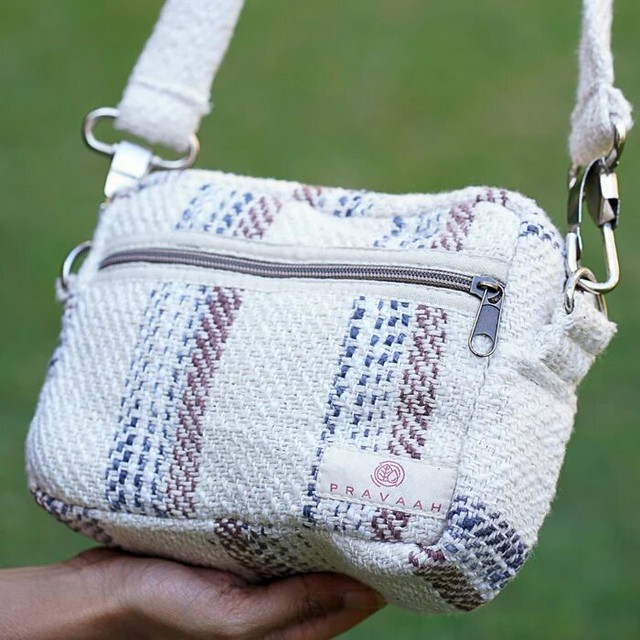#handwoven hemp
Explore tagged Tumblr posts
Text

Hmong Indigo Batik dyeing Handwoven Hemp Haori Coat (JHM-020-03)
#sawanasia#naturalfabric#handmadeasia#simpleasian#standwithsmall#kimono#hempfashion#handloomfashion#naturaldyeing#handwoven hemp#batik#hill tribe
0 notes
Text
This two-zip handwoven hemp cotton bag is not only stylish and functional, but also a conscious choice for those who care about the environment. By choosing a sustainable and eco-friendly option, you can make a positive impact on the world while also enjoying a high-quality and long-lasting product. The detachable strap allows it to be transformed into a travel pouch in no time
0 notes
Text





CACHÉISTANBUL
KENDIR El Dokuma Upcycle Hemp Kilim
%100 Doğal, Çift taraflı kullanım, Kolay Taşınabilir, Katlanabilir.
KENDIR RUG %100 doğal ve organik keçi kılından ve kenevir otundan oluşan geri dönüştürülmüş iplerden yapılmıştır.
4 gün içerisinde kargoda.
El dokuması doğası gereği renkler, desenler ve ölçüler görsellerden ufak farklılıklar gösterebilir.
Profesyonel ve ruhsat sahibi halı yıkamacılarda soğuk su ile, ağartıcı kullanmadan ve fırçalama yaptırmadan yıkatabilirsiniz. Yıkama için Türkiye içerisindeki ürünlerde bizimle iletişime geçebilirsiniz.
KENDIR RUG is made from recycled threads made from 100% natural and organic goat hair and hemp grass.
This rug is produced exclusively on order.
Delivery time for this size is 5-6 weeks. From the moment you order the product, you will be informed with a photo about the weaving process every week.
Due to the handwoven nature, colors and patterns may differ slightly from the images.
You can have it washed by professional and licensed carpet cleaners with cold water, without using bleach and without brushing. You can contact us for washing products in Turkey.
#carpet#carpet repair#carpetdesign#carpets and rugs#el dokuma#halı#handwoven#kilim#kilimrug#turkish rug#cacheistanbul#hemp#hempproducts#hemp carpet
0 notes
Text
Tunic Weaving Process
Marking my second project on a rigid heddle loom, I finally got around to finishing my not-a-cosplay-I-swear tunic to be linked (heh) in the future.
(Edit: Final product here!)
This tunic splits the difference between the original reference image here, and the comic pages. The only noticeable factors are that the hem's curve is somewhat shallow, and that the sleeve details are three parts (as versus five).
The tunic shaping is also modified to be more... Tunic-y. That is to say, made of rectangles and straight seams—so no set-in sleeves, and a bit of a wider shape to account for the woven fabric type.
It will be accompanied by a linen under-tunic and hemp-amber necklace. Made because they all look nice together, but also separately.
[ALL IDs IN ALT TEXT]
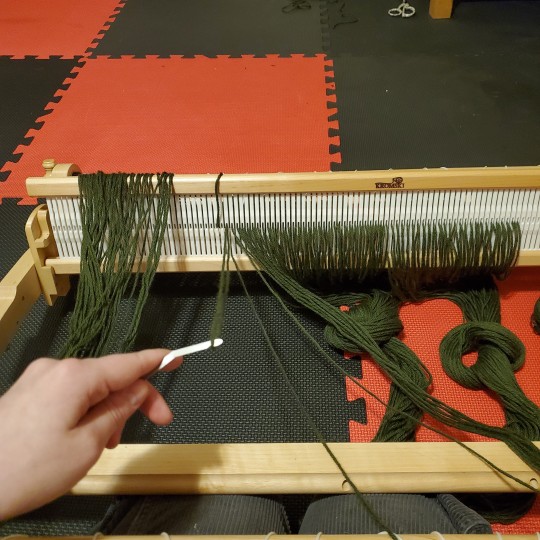
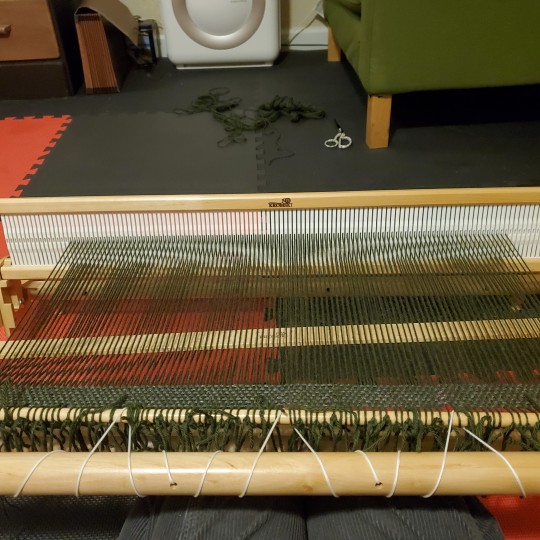
Starting out, I calculated how much yarn would be needed for the body (incorrectly), and set up all of my warp threads.
After my first project's hiccups, the warp threads were individually tied so as to minimize risk of uneven tension.
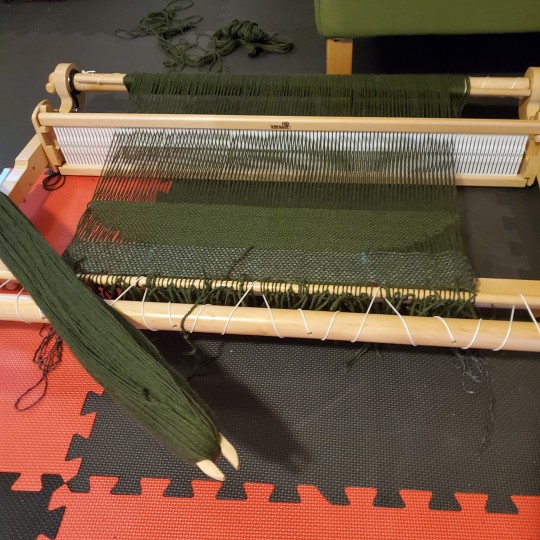
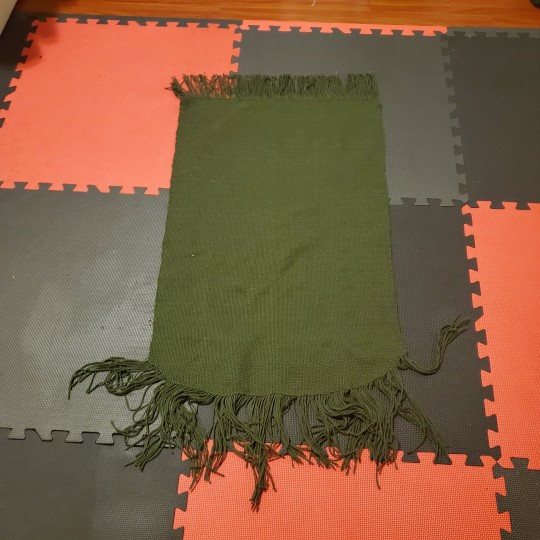
For whatever reason, I decided to curve the hem as part of the piece, rather than enforcing, trimming, and hemming to a curve. (This was also incorrect—or at least a bad move.)
The full, finished back piece is pictured above, and is a little more loosely woven than the front panel, but is still absolutely warm enough to justify material costs.


The neckline for the front was made in two parts starting at the split. The widest part of the neckline was essentially cut away. All fringe was woven in on the neckline (and the hem), and the shoulder seams were bound together with this method as well. Side seams were just back-stitched.

The neckline was crocheted with a lighter yarn as a border, and a faux closure was attached to match the reference.

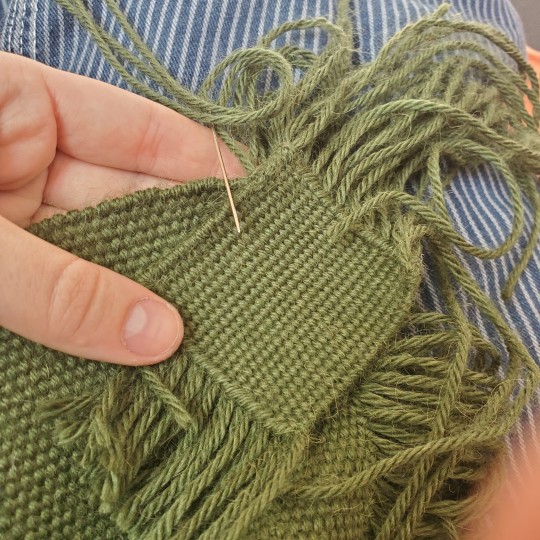
As mentioned, the smart move would have been to curve the bottom of the tunic through enforcement, trimming, and hemming, so to make the front more even with the back, this is what I ended up doing, despite that it was... Already curved.
The sleeves deserved a gusset, especially because those aid a place that would normally be a weak point on regular fabric, and would be extra prone to pulling on something handwoven like this.
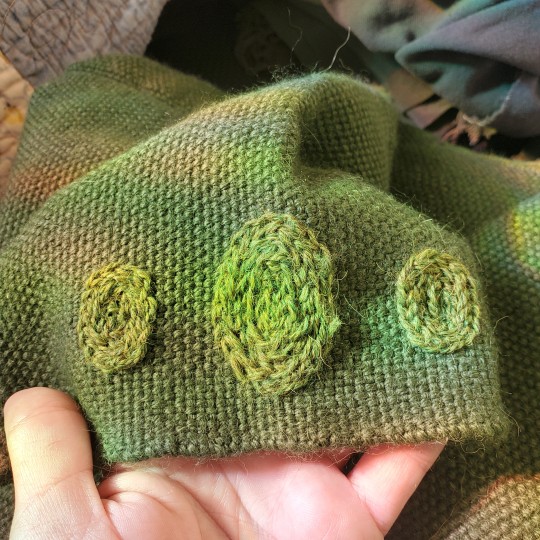
Finally, sleeve decorations were chain-stitched in the accent color to match the neckline.
It took several months of intermittent work to finish, but could have probably been less had the tall task of weaving in several hundred loose threads not daunted me so much.
It was made from alpaca, which I justify via my intention to wear this as it gets colder in the northern hemisphere, but also because I could not get my hands on hemp yarn (which would have made more sense in the context of the setting).
#id in alt text#weaving#long post#craftblr#yarn#alpaca#loom#rigid heddle loom#bonus loft#bonus links#yarnblr#artistic shenanigans#tunic#fashion#cosplay#(but not actually)
170 notes
·
View notes
Text
Slow Fashion in Vietnam: A Movement Gaining Momentum
Slow fashion is not just a trend; it's a shift in mindset. It's about valuing quality over quantity, investing in timeless pieces, and supporting sustainable practices. In recent years, the slow fashion movement in Vietnam has been steadily gaining momentum as consumers become more conscious of the environmental and social impacts of the traditional fast fashion industry. Fueled by a growing awareness of sustainable practices and a desire to support local artisans, Vietnamese brands and designers are embracing the principles of slow fashion and offering thoughtful, ethically-produced alternatives to the mass-produced garments that have long dominated the market.

Embracing Sustainable Practices
One shining example of the slow fashion ethos in Vietnam is Kilomet109, a Hanoi-based brand that showcases the country's rich textile heritage. Founded by designer Vu Thao, Kilomet109 meticulously crafts each garment, utilizing eco-friendly materials and traditional techniques (Ngo Quynh,2022). Their dedication to sustainability extends beyond the production process, as they actively promote environmental awareness and encourage responsible consumption habits among their customers.
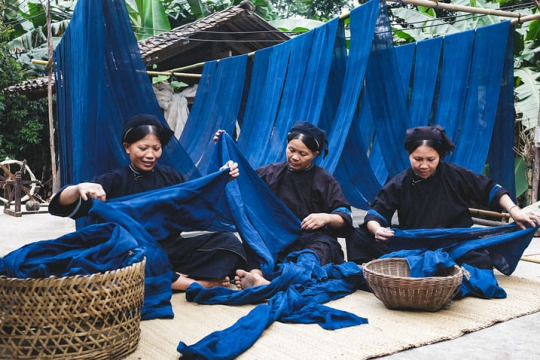
Another notable brand, Fashion4Freedom, shows the desire to use fashion to liberate and develop. Each F4F product is a true work of art thanks to its uniqueness in concept and processing. Dragon Shoes is an example. The sole of the shoe "takes advantage" of jackfruit wood purchased from local families, intricately carved. F4F also has many impressive products such as patterned costumes of the Ta Oi people, jewelry collections from phones and computers. and broken tablets, wooden jewelry... When looking at products from F4F, we have the right to be proud of a carving culture coming from traditional craft villages (Nhi Nguyen, 2022).

Environmental Benefits and Cultural Preservation
The environmental benefits of slow fashion in Vietnam are undeniable. Slow fashion brands typically utilize natural, organic materials like organic cotton, hemp, and Tencel. These materials require less water, energy, and harmful chemicals compared to conventional fast-fashion fabrics. Additionally, slow fashion emphasizes smaller production batches, minimizing textile waste, a significant environmental concern in the global fashion industry.
Furthermore, slow fashion in Vietnam celebrates and revitalizes traditional craftsmanship techniques. Many brands collaborate with local artisans who possess skills in weaving, dyeing, and embroidery passed down through generations. This not only preserves cultural heritage but also empowers local communities by providing sustainable livelihoods for artisans. Brands like Gia Studio, which uses natural dyes and handwoven fabrics to create traditional Vietnamese clothing, are examples of this cultural preservation (Pameyla Cambe,2024)

A promising for future
The slow fashion movement in Vietnam is still in its early stages, but it has the potential to make a significant impact on the global fashion industry. As more and more Vietnamese consumers embrace slow fashion principles, the industry is poised to play a significant role in reducing the fashion industry's environmental impact and promoting ethical labor practices.

The rise of slow fashion in Vietnam signals a promising shift towards more sustainable and socially responsible consumption. As this movement grows, it not only brings environmental and economic benefits but also strengthens the cultural fabric of Vietnamese society, weaving a future where fashion respects both people and the planet.
References
Cambe, P. (2024, April 2). Vietnamese Fashion Brand Gia Studios Is Crafting The Ultimate Minimalist Wardrobe. Grazia Singapore. https://grazia.sg/fashion/gia-studios-lam-gia-khang-vietnamese-fashion-brand-minimalist-interview/
Maker Profile: Kilomet109. (2017, September 21). THE KINDCRAFT. https://thekindcraft.com/kilomet109/
Nguyen, N. (2022, July 18). 5 thương hiệu thời trang việt bền bỉ theo đuổi sự bền vững. Vietcetera. https://vietcetera.com/vn/5-thuong-hieu-thoi-trang-viet-ben-bi-theo-duoi-su-ben-vung
Quynh, N. (2022). Top 10 thương hiệu thời trang bền vững nổi tiếng tại Việt Nam. Coolmate. https://www.coolmate.me/post/cac-thuong-hieu-thoi-trang-ben-vung-tai-viet-nam
3 notes
·
View notes
Text






With its beautiful woven design, this lantern creates captivating light patterns when illuminated. Simply place a tea light or LED candle inside to experience a gentle and warm glow that adds a magical touch to your evenings.
Versatile and lightweight, our lantern can be hung from hooks or placed on any flat surface, both indoors and outdoors. It's perfect for creating a cozy atmosphere in your living room, bedroom, patio, or garden.
15 notes
·
View notes
Note
Hello there,
I had a question about the Shinsengumi uniform and I thought you may be able to help me. I have recently been thinking of recreating their light-blue haori and wondered if you might know the proper fabric that should be used for it and how one adds the white mountain patterns at the cuffs. Do they need to be part of the fabric itself or can they be sewed on or embroidered? These might sound like silly questions but I can't seem to find the proper answer anywhere.
Thanks
Hi, thanks for asking!
Part 2 from this post would be useful. According to Nagakura's diary, the Shinsengumi uniform was made by the Daimaru store. They've recently created a reproduction using handwoven linen and natural dyes (probably using light indigo to get asagi blue). It's also possible that the uniform was made from coarse hemp due to financial constraints in the Shinsengumi at that time.
I haven't found anything about how the Shinsengumi originally added the patterns to the cuffs, but from the close-up photos of Daimaru's reproduction, they're part of the fabric itself using a resist-dyeing technique, where the rest of the uniform blue is dyed blue and the patterns on the cuffs are left white along with the “誠” (sincerity) character on the back.



Let me know if you need any more help. Would be cool to see how it turns out 😊
29 notes
·
View notes
Text
The Versatile World of Linen and Fabrics: A Guide to Natural Textiles
sustainable community
In a world where sustainability and comfort go hand in hand, textiles like linen, hemp, wool, and bamboo are making waves in fashion and interiors. This blog explores the wide variety of natural and sustainable fabrics, highlighting their uses, advantages, and trends.
1. Linen and Its Variants
Linen has always been synonymous with luxury and durability. Known for its breathability, linen fabric is a favorite in clothing and home textiles. Whether it’s fabric linen for upholstery or linen cloth for fashion, this textile offers unmatched versatility.
Why Choose Linen? Linen absorbs moisture, keeping you cool in summer and warm in winter. It’s also biodegradable, aligning perfectly with eco-conscious lifestyles.
Popular Uses: From linen and fabrics for drapes to lightweight summer clothing, linen remains a go-to choice for many.
2. Exploring Dyed Fabrics
Natural dyes and innovative techniques bring fabrics to life. Whether it’s dyes and fabrics for vibrant hues or dyed clothes for fashion-forward statements, dyed textiles have a charm of their own.
Natural Dyed Fabrics: These are crafted using plant-based dyes, reducing environmental impact.
Popular Choices: Naturally dyed fabrics, dyed cloth, and dyed clothing.
3. Wool Fabrics: The Cozy Alternative
Wool is a timeless favorite for cold weather. From wool fabric wool to merino wool, these textiles combine warmth with style.
Wool Varieties: Woolen fabrics, wool cloth, and wool cloths cater to various needs, from jackets to blankets.
Eco-Friendly Advantage: Wool is renewable and durable, making it a sustainable choice.
4. Hemp: The Fabric of the Future
Hemp textiles are gaining traction for their strength and eco-friendliness. As a fast-growing plant, hemp produces textiles like hemp fabric, hemp garments, and hemp as fabric that are biodegradable and long-lasting.
Key Uses: Hemp fabric textiles and hemp for clothing are popular among sustainable fashion brands.
5. Bamboo Fabrics: The Soft and Sustainable Choice
Bamboo is a rising star in sustainable textiles. From bamboo fabric material to bamboo clothing fabric, this fabric offers comfort and sustainability.
Advantages: Bamboo fabrics are hypoallergenic, moisture-wicking, and incredibly soft.
Popular Variants: Bamboo fiber fabric, bamboo cloth material, and fabric from bamboo.
6. Other Noteworthy Fabrics
Khadi Fabric: A handwoven, eco-friendly textile rooted in tradition.
Organic Cotton Fabric: Soft, breathable, and ideal for sensitive skin.
Muga Silk: A luxurious, golden silk native to India.
Bemberg Fabric: A regenerated cellulose fabric known for its silky texture.
7. Sustainable Choices in Modern Textiles
The shift towards organic fabrics and natural textiles is driven by environmental awareness. Options like rose fabric, banana fibre, and organic natural cotton fabric are becoming mainstream in eco-conscious industries.
Conclusion: A Fabric for Every Need
Natural and sustainable fabrics are not just trends; they’re the future of textiles. Whether you’re looking for denim cloth fabric for rugged use or lotus silk for opulence, there’s a fabric for every purpose. By choosing eco-friendly options like organic cotton textiles or natural dyed fabrics, you’re contributing to a greener planet while enjoying premium quality.
Feel free to explore these incredible fabrics at Suvetah, your one-stop destination for sustainable textiles. Let’s weave a sustainable future, one fabric at a time!
Suvetah — All things nature

Suvetah is a brand dedicated to reconnecting individuals with nature through a curated selection of 100% natural, sustainable, and eco-friendly textile products and services. Their mission centers on customer satisfaction and promoting a lifestyle that embraces natural materials.
Product Offerings:
Natural Fabrics: Suvetah offers over 50 varieties of natural fabrics and yarns, including Ahimsa silk, hemp, bamboo, banana, khadi, and organic cotton.
Suvetah
Dyed and Printed Fabrics: The brand specializes in natural dyeing, block printing, and eco-printing techniques, ensuring that their textiles are both environmentally friendly and aesthetically pleasing.
White Fabrics: For those seeking untreated materials, Suvetah provides a range of organic white fabrics suitable for various applications.
Services:
Custom Textile Solutions: Suvetah caters to bulk organic textile needs, offering custom solutions under one roof. Their swatch book serves as a comprehensive resource for sustainable and ethical brands.
Garment Construction: Beyond fabrics, Suvetah provides services related to garment construction, ensuring that the journey from fabric to finished product aligns with sustainable practices.
Brand Philosophy:
Suvetah is committed to re-establishing the bond between humans and nature. By focusing on natural and eco-friendly products, they aim to promote a sustainable lifestyle. Their vision is encapsulated in the motto: “Live natural, wear natural.”
Customer Testimonials:
Clients appreciate Suvetah’s professionalism and dedication to sustainability. One testimonial highlights their role as a “one-stop-shop solution for all your Organic, fair trade, sustainable, and most ethical fabrics, dyes, and prints.”
Location:
Suvetah operates under Pahartah Fashion LLP, located in Dharamshala, Kangra, Himachal Pradesh, India.

Linen And Fabrics
Fabric Linen
Fabric
Clothing
Organic Clothing
#Sustainable Fabric#organic fabric#painted fabric#silk fabrics#organic fabrics#cotton fabric#linen fabric#cottony fabric#fabric#fabrics#online fabrics#satin fabrics#WOOL FABRIC#silk sarees#fabrics linen#sustainable silk sarees#online fabric material#sustainable clothing manufacturing services#linen cloth material#cotton fabrics#cotton material fabric#organza#woollen fabrics#woolen fabric#organza fabric
0 notes
Text
Jute Cotton Rugs: Style, Sustainability, and Durability Combined
In today’s world, where sustainability meets style, Jute Cotton Rugs have carved a unique niche. Their natural fibers, eco-friendly manufacturing, and exceptional durability make them a perfect choice for any home. Whether you’re shopping for Jute Cotton Rugs online in India or seeking to import them globally, these rugs are a blend of traditional craftsmanship and modern aesthetics. Let’s dive into why these rugs are a must-have and how they can transform your space.

Why Choose Jute Cotton Rugs?
Style That Complements Any Space Jute cotton rugs boast a natural charm that adds warmth and elegance to interiors. Their neutral tones and intricate patterns work seamlessly with a variety of décor styles—from rustic and bohemian to modern minimalist.
Sustainability at Its Core Jute and cotton are biodegradable and renewable materials. Opting for Online Hemp Jute Rug in India or any other natural blend contributes to a greener planet while giving your home a chic touch.
Unmatched Durability Thanks to their sturdy weave, Jute Cotton Rugs can withstand high foot traffic areas like living rooms, hallways, and entryways. Their durability makes them a favorite among homeowners and interior designers alike.
Finding the Perfect Jute Cotton Rugs Online
1. For Local Shoppers in India
India is home to some of the world’s best Braided Jute Rug Manufacturers and Cotton Rugs Manufacturers in India, offering exquisite collections. Shopping for Jute Cotton Rugs online in India provides endless options in design, size, and color to suit your space.
2. For International Buyers
Looking to source rugs for your retail or wholesale business? Renowned Jute rugs exporter for USA, and Wool Jute Rugs Exporters in India offer quality products that meet international standards. Indian rug exporters are known for their handwoven designs, ensuring that each piece is both functional and artistic.
Popular Variations of Jute Cotton Rugs
Braided Jute Rugs Crafted using traditional techniques, braided rugs are a timeless classic. They add texture and a cozy vibe to any room. Seek out Braided Jute Rug Manufacturers, for custom designs and wholesale options.
Hemp and Jute Blends Online Hemp Jute Rugs in India combine the sturdiness of hemp with the softness of jute for a unique product perfect for sustainable homes.
Wool Jute RugsThese rugs combine the warmth of wool with the rustic beauty of jute, making them a premium choice for both comfort and durability. Many Wool Jute rugs exporter in India, cater to international markets with innovative and luxurious designs.
Tips to Style Jute Cotton Rugs
In the Living Room: Place a large Jute Cotton Rug under your coffee table for a cohesive look.
In the Bedroom: Use a smaller rug beside your bed for a soft landing every morning.
On the Patio: Opt for braided or durable options to add natural beauty to outdoor spaces.
Caring for Your Jute Cotton Rugs
To maintain their beauty and longevity:
Vacuum regularly to remove dust and debris.
Avoid placing them in areas prone to excessive moisture, as jute absorbs water.
Use a rug pad to prevent slippage and reduce wear.
Conclusion
Jute Cotton Rugs are more than just floor coverings—they’re a statement of style, sustainability, and practicality. Whether you’re a homeowner looking for the perfect rug or a business seeking Jute Rugs Exporters for the USA, India is a hub for high-quality options. With their timeless appeal and eco-friendly benefits, Jute Cotton Rugs are an investment you’ll cherish for years to come.
Ready to shop? Explore the best Jute Cotton Rugs online in India today and bring home a piece of sustainable luxury.
0 notes
Text
Benefits of Hemp Rugs for Sustainable Living

We are delighted to introduce our new collection of handwoven hemp rugs, combining natural fiber for the base with goat hair for the pattern.These are original designs crafted by our Turkish designer, the winner of a young designers' competition for rugs in Istanbul.
0 notes
Text
#RugForLivingRoom#TuftedRug#FestiveEtsyFinds#JuteRunner#JuteRug#NaturalFiberRug#HempRug#ScallopedJuteRug#CustomColorRug#CustomJuteRug#BohoDecorRug#ScallopJuteRug#HandwovenRug#EcoFriendlyRug#JuteWeave#HandBraidedRug#CircleAccentRug#JuteRoundRug#RoundSisalRug#seagrassrug#modernjuterug#SisalRug#ovalrug#creamrugsisal#Ecofriendlyrug#VeganRug#EcologicRug#EcologicHomeDecor#VegetalRug#hallwayrunner
0 notes
Text
Tired of losing things in your bag? Irritated with disorganised cables, stationary or make up? Hating on the dirty bag that can only be dry cleaned if at all?
Look no further, we got you covered. Named Pai (Pouch in Tamil: பை), this pouch is made from handwoven hemp and cotton blended yarn. The interior is lined with 100% cotton. You can wash each piece easily and at home!
0 notes
Text
Comprehensive Guide to Bohemian Shoulder Bags and Boho Hippie Bags
In the realm of fashion accessories, bohemian shoulder bags and boho hippie bags stand out as quintessential pieces that blend style, functionality, and cultural heritage. At Clothing in Nepal, we delve into the allure of these unique bags, offering a curated collection that speaks to the free-spirited individualist in you.
Understanding Bohemian Shoulder Bags and Boho Hippie Bags
Bohemian shoulder bags and boho hippie bags are more than just accessories; they are statements of personal style and ethos. Rooted in the bohemian and hippie movements of the 1960s and 1970s, these bags embrace a carefree, unconventional vibe. They often feature vibrant colors, intricate patterns, and a variety of textures that reflect global influences and artisanal craftsmanship.
The Artistry Behind Each Bag
What sets bohemian shoulder bags and boho hippie bags apart is their emphasis on craftsmanship and authenticity. Many of these bags are handmade by skilled artisans using traditional techniques passed down through generations. From handwoven fabrics to intricate embroidery and beadwork, each bag tells a story of cultural richness and creativity. By choosing these bags, you not only elevate your outfit but also support sustainable fashion practices and empower artisans around the world.
Versatility in Design and Functionality
One of the defining features of bohemian shoulder bags and Boho hippie bags is their versatility. They effortlessly complement a wide range of outfits and occasions, whether you're heading to a music festival, exploring a bustling market, or simply strolling through the city streets. Their spacious interiors and secure closures make them ideal companions for storing essentials while adding a touch of bohemian flair to your ensemble.

Embracing Bohemian and Hippie Fashion
Bohemian and hippie fashion celebrate freedom of expression and a connection to nature and community. Bohemian shoulder bags and boho hippie bags embody these values by incorporating natural materials such as cotton, hemp, and leather, often sourced ethically and sustainably. They resonate with individuals who value authenticity and seek to express their unique personalities through fashion.
Styling Tips for Bohemian Shoulder Bags and Boho Hippie Bags
Finding the perfect way to style your bohemian shoulder bag or boho hippie bag is an adventure in itself. Pair a colorful embroidered crossbody bag with a flowing maxi dress for a bohemian chic look, or opt for a fringed leather shoulder bag to add a touch of rugged elegance to your outfit. Experiment with layering jewelry and accessories to enhance the eclectic charm of these bags and create a look that is uniquely yours.
The Timeless Appeal of Bohemian Fashion
While trends come and go, bohemian shoulder bags and boho hippie bags endure as timeless pieces that transcend fashion cycles. They symbolize a lifestyle rooted in creativity, individuality, and a reverence for cultural diversity. At Clothing in Nepal, we celebrate this enduring appeal with our handpicked selection of bohemian shoulder bags and boho hippie bags, each designed to inspire and empower you on your journey of self-expression.
Conclusion
Whether you're drawn to the vibrant colors and intricate designs of bohemian shoulder bags or the laid-back charm of boho hippie bags, these accessories offer more than just functionality; they represent a way of life. Explore our collection at Clothing in Nepal and discover how these bags can complement your unique style while supporting sustainable fashion practices and artisan craftsmanship.
0 notes
Text

Hmong Indigo Batik dyeing Handwoven Hemp Sashiko Kimono Dress
#Mother's Day#handwoven batik#Vintage Hmong#sawanasia#naturalfabric#handmadeasia#indigolove#naturaldyeing#hempfashion#hill tribe#standwithsmall
0 notes
Text
We bring to you an eco friendly option to the plastic/synthetic material laptop cases, our Pai laptop sleeve is made in a Hemp cotton handwoven fabric. It is washable and safe for the environment. The lining of the product is also completely done by hand and is in pure cotton.
0 notes
Text






Illuminate your space with a touch of bohemian charm using our handcrafted hemp lantern. This intricately handwoven lantern adds a natural and cozy ambiance to any room or outdoor setting.
Crafted by skilled artisans, each lantern is made from sustainable hemp fibers, known for their durability and eco-friendliness. The natural tan color of the material complements any decor style, from rustic farmhouse to modern boho
10 notes
·
View notes
